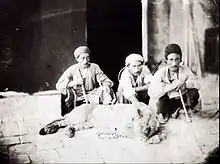Khuzestan Plain
The Khuzestan Plain is the relatively flat region of Iran where the Khuzestan province and the cities of Ahvaz, Susa and Abadan are located. It is the largest plain in Iran and one of the richest agricultural areas in the world. It is irrigated by several big rivers such as Karun and Karkheh. Khuzestan Plain borders Mesopotamia and is separated from it by the Shatt al-Arab (known as Arvand Rud in Iran) river.
Khuzestan was the center of the ancient Elamite culture of Iran.
Wildlife

In the 19th and early 20th centuries, the Asiatic lion was recorded in Fars Province, Ramhormoz County, Shushtar County, Dezful County and along the Karun river.[1][2][3][4]
See also
References
- Heptner, V. G.; Sludskii, A. A. (1992) [1972]. "Lion". Mlekopitajuščie Sovetskogo Soiuza. Moskva: Vysšaia Škola [Mammals of the Soviet Union, Volume II, Part 2]. Washington DC: Smithsonian Institution and the National Science Foundation. pp. 83–95. ISBN 978-90-04-08876-4.
- Humphreys, P., Kahrom, E. (1999). "Lion". Lion and Gazelle: The Mammals and Birds of Iran. Avon: Images Publishing. pp. 77−80. ISBN 978-0951397763.CS1 maint: uses authors parameter (link)
- Firouz, E. (2005). "Lion". The complete fauna of Iran. I. B. Tauris. pp. 65−66. ISBN 978-1-85043-946-2.
- Khosravifard, S.; Niamir, A. (2016). "The lair of the lion in Iran". Cat News (Special Issue 10): 14–17.
This article is issued from Wikipedia. The text is licensed under Creative Commons - Attribution - Sharealike. Additional terms may apply for the media files.
